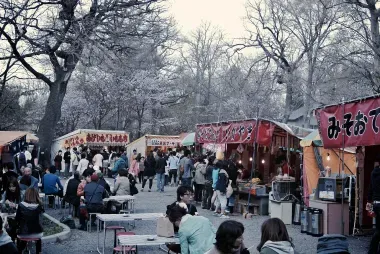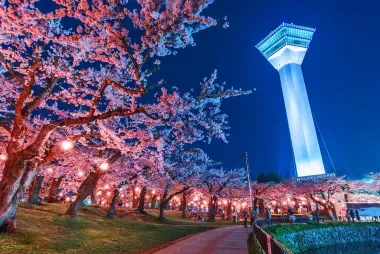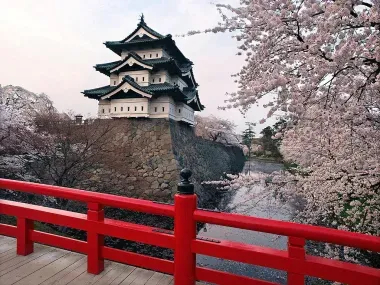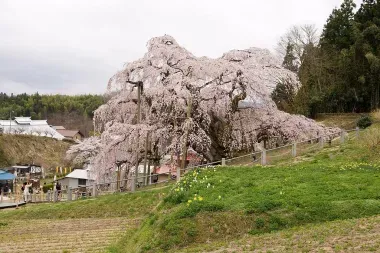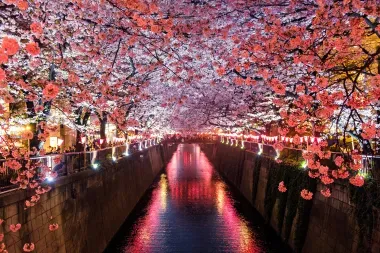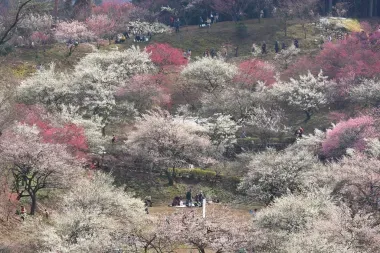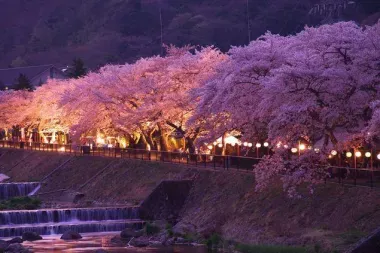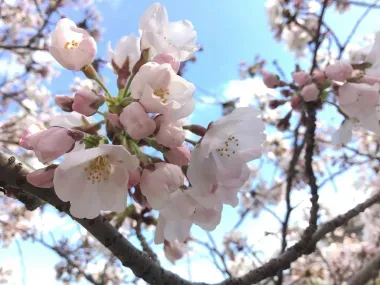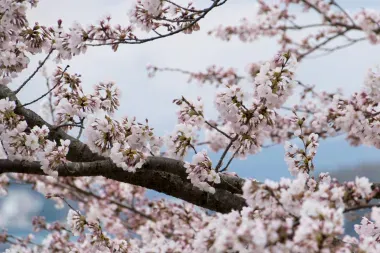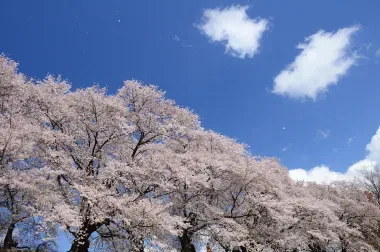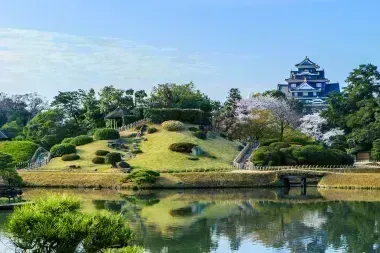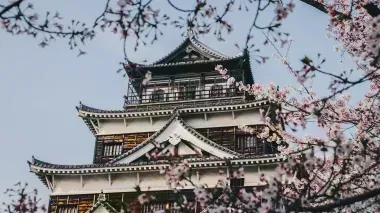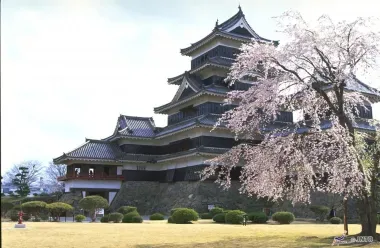Where to admire the cherry blossoms in spring
Japan is renowned for its distinct and beautiful seasons. One of the most eagerly awaited is undoubtedly spring, with the blossoming of the sakura cherry trees. Every year, thousands of visitors from all over the world travel to Japan to witness this breathtaking spectacle, known as"Hanami".
Cherry Blossoms are much more than just a flower in Japan. It symbolizes life on earth in all its beauty and fragility. However, its blooming patterns, accentuated by the variables in weather, make forecasting difficult.
Hanami, which means "watching the flowers," is not just a natural occurrence from going outside, it's a tradition rooted in Japanese culture for centuries, a time when families, friends, and even strangers gather to celebrate the ephemeral beauty of Sakura. So, where and when can you expect to see these splendid spring blooms in 2024?
Forecasts for Cherry Blossom 2024
Here are the weather forecasts and expert estimates for cherry blossom in 2024:
- Cherry blossoms are set to start earlier than usual in 2024, spreading from south to north and affecting central regions such as Tokyo and Kyoto as early as mid-March.
- It should be noted that each region has its own flowering trends, but generally speaking, from the 3rd week of March, the first petals will appear in Tokyo and Kyoto. This marks the start of a period eagerly awaited by people in Japan and visitors from all over the world.
- This blossoming period, which usually lasts from March to April and continues until May, will be a spectacular time when cherry blossoms will transform the Japanese landscape into a veritable floral paradise.
So, in 2024, fans of Hanami can look forward to a particularly early and beautiful season, when streets and parks will be adorned with delicate pink and white flowers, creating a fairytale-like and memorable atmosphere.
Cherry blossom viewing spots by region
HOKKAIDO:
- Sapporo: Maruyama Park
Although Hokkaido is further north and the cherry blossoms bloom later, Maruyama Park in Sapporo is well worth a visit for its majestic cherry trees. It's the perfect place to end the Hanami season in style. Maruyama Park is also famous for housing the majestic Hokkaido-jingu shrine, adding a spiritual dimension to the spellbinding experience of gazing at the cherry blossoms.
- Hakodate: Goryokaku Park
Goryokaku Park in Hakodate offers spectacular views of the cherry blossoms. It's definitely worth climbing up to the observation tower for a breathtaking view of the park. With its shady walkways and star-shaped moat, it's a truly unique place to enjoy the beauty of the spring cherry blossoms.
TOHOKU:
- Hirosaki: Hirosaki Castle
The Tohoku region is famous for its cherry blossoms, and Hirosaki Castle Park is no exception. With over 2,600 cherry trees, this park offers breathtaking views, especially when the cherry trees are illuminated at night.
- Fukushima: Miharu Takizakura
Miharu Takizakura, the huge weeping cherry tree, is one of Japan's three giant cherry trees . With a height of 13 meters, this tree is said to be over 1,000 years old. Each branch of this tree is home to countless beautiful cherry blossoms. It is dubbed " Takizakura (cascade of cherry blossoms)" This tree is even more beautiful at night when illuminated.
KANTO:
- Tokyo: Nakameguro River
Offers a magnificent walk beneath cherry blossoms, interlaced with pink lanterns. More than 800 yoshino cherry trees compete to dazzle the eyes of walkers. As night falls, the lanterns light up and the pink reflections mingle with the yozakura, the night cherry trees.
Shinjuku Gyoen:
Shinjuku Gyoen Park is one of the most popular places to enjoy cherry blossoms in Tokyo. With over 1,000 cherry trees of different varieties, this vast park offers an ideal setting for picnics under the bright pink and white blossoms.
KANSAI:
- Kyoto: Philospher's Path
The Path of Philosophy, or Tetsugaku no michi, is a charming cherry-tree-lined promenade that runs alongside a canal in Kyoto. This picturesque destination is ideal for a leisurely stroll while admiring the cherry blossoms reflected in the water.
- Nara: Mount Yoshino
A famous place to see cherry blossoms, with over 30 ,000 trees of different varieties. The mountain is decked out in pink and white in spring. Travelers from all over the world come here to enjoy this ephemeral beauty. The surrounding gardens and parks offer a peaceful atmosphere in which to stroll and contemplate nature's awakening splendor.
SHIKOKU:
- Takamatsu: Ritsurin-koen
This garden is one of Japan's national treasures, where every stone, every tree, and every pond tells a thousand-year-old story of beauty and serenity. In spring, it's a haven of peace where you can lose yourself in contemplation of the carefully landscaped grounds, surrounded by hues of pink flowers and enveloped by the peaceful atmosphere that reigns here.
- Mitoyo: Shiudeyama
With its panoramic views over the surrounding valley, Mount Shiude is also renowned for its cherry blossoms in spring. Each year, as the cherry blossoms bloom on its slopes, Mount Shiude is transformed into a fairytale tableau, inviting visitors to lose themselves in the ephemeral splendor of the Hanami season.
KYUSHU:
- Kagoshima: Shiroyama Park
This iconic site offers a breathtaking view of the sparkling bay, punctuated by cherry blossom trees, against the backdrop of the active Sakurajima volcano, which adds an aura of mystery and grandeur to this spectacular landscape.
- Kumamoto: Kumamoto Castle Park
Nestled in the heart of Kumamoto town, Castle Park evokes a timeless charm, where the peaceful beauty of its gardens, punctuated by cherry blossom trees, contrasts magnificently with the majestic castle walls. In the background, the imposing silhouette of Mount Aso adds a touch of natural majesty to this enchanting view, offering visitors an unforgettable experience steeped in history.
CHUGOKU:
- Hiroshima: Senkoji Park
Perched high above Hiroshima, the park envelops visitors in an atmosphere of serenity. Offering breathtaking views of the city and the Seto Inland Sea , this verdant sanctuary is dotted with cherry blossom trees that add a touch of grace to the landscape. In the distance, the silhouettes of the sea islands cut into the horizon, creating an enchanting backdrop for this peaceful getaway.
- Okayama: Korakuen Garden
In this garden, every corner reveals a dazzling beauty. The reflections of cherry blossom in the sparkling ponds create a magical atmosphere, while the bridges add a touch of grandeur. With Okayama Castle on the horizon, this garden steeped in history offers a captivating experience, where nature and architecture blend harmoniously.
CHUBU:
- Mount Fuji: Lake Kawaguchi
Bordered by the majestic peaks of Mount Fuji, Lake Kawaguchi reveals a breathtaking beauty. Its calm waters reflect the imposing silhouette of the sacred volcano, creating a breathtaking spectacle. Surrounded by lush greenery and picturesque villages, this lake offers a peaceful escape, where every glance captured reveals the timeless magic of this emblematic Japanese landscape.
- Nagano: Matsumoto Castle
Matsumoto Castle stands proudly above the city, offering an imposing glimpse of Japanese history. Its towers and stone walls (reminiscent of the days of feudal lords). Whether shrouded in cherry blossom in spring or snow in winter, every visit offers a captivating immersion in Japanese culture.
Tips for making the most of the Hanami experience
- Arrive early: Popular parks can get very crowded during cherry blossom season. Arriving early in the morning can help you avoid the crowds and find the best spot for your picnic.
- Bring snacks and drinks: Hanami is often accompanied by picnics under the cherry trees. Bring your own food and drinks to make the most of the experience.
- Prepare for the weather: Spring weather can be unpredictable. Be sure to bring appropriate clothing to protect you from the sun or a cool breeze.
Whether you choose to visit Tokyo's famous parks or explore Kyoto's hidden treasures, the cherry blossom season offers an unforgettable experience in Japan. So get your camera and picnic blanket ready, and prepare to be amazed by the ephemeral beauty of the cherry blossoms!
Find out more here:


